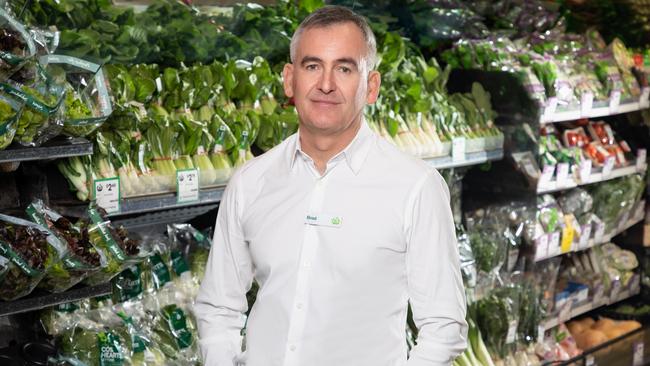Supermarket’s first quarter food inflation at 7.3pc, led by double-digit jumps in fruit and vegies
Double-digit price rises in fruit and vegetables has driven food inflation to 7.3 per cent at Woolworths, with delays to seasonal fruit like cherries threatening more hikes.
Woolworths boss Brad Banducci says food inflation at his supermarkets has accelerated to 7.3 per cent over the three months to September 30, led by large price hikes in fruit and vegetables due to poor weather conditions.
Upward pressure on fruit and vegetable prices could get worse with some growing seasons for key supermarket foods like cherries and some fruits delayed by the wet spring and cold weather now blanketing the east coast.
There were also concerns about stone fruits coming out of the northern Victorian growing area around Shepparton, which has been hit by floods, while poorer potato harvests could threaten the supplies.
Woolworths on Thursday unveiled its first quarter trading performance, with total sales down 1.8 per cent to $16.36bn, but all eyes were on its report of inflation at its flagship Australian supermarkets and the outlook for food supplies.
The nation’s biggest supermarket chain said average prices increased 7.3 per cent compared to the first quarter of 2021 and was fuelled by double-digit inflation in fruit and vegetables. The price hike was triggered by inclement weather, as well as inflation in red meat, driven by higher commodity prices, and dairy products driven by higher milk farm gate prices. In long life, inflation was mainly driven by higher supplier price increases due to cost pressures.
The faster pace of food inflation at Woolworths was also mirrored by Coles, which last month reported its first quarter trading and said inflation had been particularly strong in fresh food with prices up 8.8 per cent for the period, driven by key food items across wheat, bakery and fruit. Total supermarket price inflation of 7.1 per cent was recorded for the first quarter at Coles.
The rising prices paid at the checkout for food and groceries is growing as a tightening vice around household budgets and comes amid rising energy prices and mortgage rates.
Mr Banducci said inflationary pressures were witnessed across the supermarket aisle, which was an unusual phenomenon, but he hoped would start to moderate.
“At the full-year one of the things that really struck us was every (food) category had a different story, but all of them were in inflation, it was quite unusual, because normally you can get a balance in the basket, some areas are inflation and some are not,” he said. “That still continues, but we do believe in the next quarter inflation will start to moderate from where it is today,” he added.
Mr Banducci said the impact on consumer spending habits due to rising food inflation was a move to value as shoppers filled their baskets with traditionally cheaper groceries to make their dollar stretch further.
“A number of customers shop to a very predictable amount every week, and you can start to see them judge how many items they put in the basket in order to meet their budget,” he said.
At its Australian supermarkets, sales fell 0.5 per cent for the first quarter to $12.2bn. Online sales for its Australian supermarkets fell 10.8 per cent and Big W e-commerce sales were down 51.8 per cent as shoppers released Covid-19 restrictions shopped in stores rather than online.

Mr Banducci said poor weather conditions and disrupted supply chains could see a squeeze on supplies of some grocery categories such as frozen food and chips.
“The big issue right now is frozen vegetables, in particular corn and potatoes with the very poor growing season that we have had in Tasmania and so that is causing some challenges in the frozen category, and some risk of under supplies in some stores. That has also flowed through to some risks – but I don’t want to overplay anything at this stage – in potato crisps. That’s the big one,” he said.
Meanwhile, total Woolworths sales, spread across its food, e-commerce, business to business sales and its general merchandise store Big W, were up 1.8 per cent to $16.363bn. It was slightly below some analyst expectations of around $16.6bn.
Shares in Woolworths ended 3.5 per cent lower at $32.05.
At its general merchandise chain, BIG W, sales rose 30.1 per cent over the three months to October, following store closures last year due to the pandemic.
For its local B2B arm, which includes food services company PFD, Woolworths said sales rose 26 per cent to $1.19bn as the business benefited from a normalisation in trading conditions with growth across all customer channels, new customer acquisition and higher inflation. B2B Supply Chain – which sells supply chain solutions to other businesses – reported an increase in sales of 3.4 per cent to $306m for the quarter.






To join the conversation, please log in. Don't have an account? Register
Join the conversation, you are commenting as Logout